| |
| 
Dragonflies and their nymphs are voracious
predators. They hunt by sight, detecting prey by its movement.
Nymphs need food to grow large enough to transform
to adults. They don’t use a lot of energy foraging,
so most of what they eat is converted into body tissues.
Adults do not grow, but they must build up reserves for
breeding. Dragonflies can double their weight as they pass
from teneral to mature adult, growing larger flight muscles
and storing fat. Adults convert some of their food to body
tissues, and to eggs and sperm, but most is turned into
energy for flight.
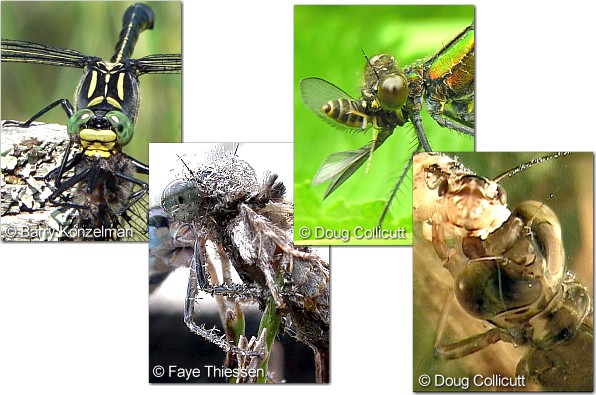
|
|  Do dragonflies drink? Adults get
much of the water they need from the food they eat,
but will drink from water surfaces or droplets of
dew.
Do dragonflies drink? Adults get
much of the water they need from the food they eat,
but will drink from water surfaces or droplets of
dew.
|

|
|
Small nymphs feed on tiny aquatic invertebrates. As they grow
they eat larger invertebrates and even small fish
and tadpoles. Most hunt by sight, but some use their
antennae to feel movement. They aren’t picky
about what they eat. If it moves and is about the
size they think they can handle, they go for it! |
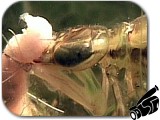
Watch a nymph eat a worm.
(Video = 30 sec., 1.0 Mb)
|
| |
Watch a higher resolution version of this video on YouTube. Click Here: Nymph Eating! |
|
|
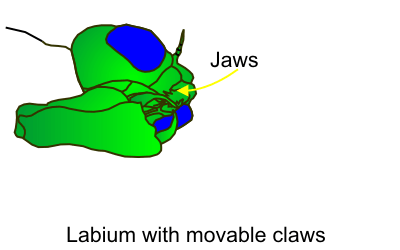
|
Nymphs catch
prey with their labium, a modified lower lip that shoots
out with lightning speed. The labium holds prey firmly as
the jaws tear it apart. Nymphs of some species crawl through
aquatic plants looking for prey. Others wait in ambush,
lying hidden in mud or clinging to plants or rocks.
(Animation to the left shows the labium in action in slow
motion.) |
|

 Most
nymphs are green or brown to match the colour of aquatic
plants or a mud bottom. They are camouflaged to hide
from their prey AND their predators. Most
nymphs are green or brown to match the colour of aquatic
plants or a mud bottom. They are camouflaged to hide
from their prey AND their predators.
|
|
| 
 Dragonflies
are aerial hunters that catch and eat other flying insects.
Small prey can be caught directly in their jaws or they
can use their spiny legs like a basket to snare insects.
When larger prey is caught, dragonflies usually perch somewhere
to eat it, but smaller prey can be eaten in flight. Dragonflies
are aerial hunters that catch and eat other flying insects.
Small prey can be caught directly in their jaws or they
can use their spiny legs like a basket to snare insects.
When larger prey is caught, dragonflies usually perch somewhere
to eat it, but smaller prey can be eaten in flight.
Dragonflies are opportunistic hunters
and will take whatever prey is available, but each species
hunts in its own way. Some, like many Darners (Aeshnidae),
spend much of each day flying, searching for food. Others
spend more time perched, waiting for prey to fly by. Many
Clubtails (Gomphidae) perch on the ground, while many Skimmers
(Libelluidae) perch on low vegetation. Species will differ
in the time of day when they hunt (daytime or dusk), where
they hunt (forest, meadow or marsh) and what they hunt (large
or small insects). Some, especially damselflies, will snatch
insects off the ground or from vegetation. |
|
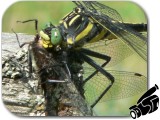
Watch some dragonflies chowin'
down!
(Video = 0:23, 0.7 Mb.) |
Watch a higher resolution version of this video on YouTube. Click Here: Chowin' Down! |
|
|  
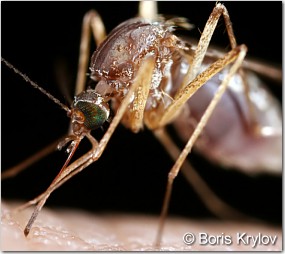 Most
dragonflies hunt during the daytime, when it is sunny
and warm. Most mosquitoes remain hidden in the daytime,
so they’re not a major food item for most dragonflies.
Nymphs will eat mosquito larvae, but most nymphs live
in permanent water bodies, while mosquitoes breed
mainly in temporary waters. Mosquitoes can have several
generations in one summer, so their populations can
rise dramatically in a short time. Dragonflies
have only one generation each year, so their numbers
cannot increase to match mosquito populations. Dragonflies
are an important part of wetland ecosystems, but they
can’t control mosquito numbers. In nature, the
availability of prey usually limits predator populations,
not the other way around. Most
dragonflies hunt during the daytime, when it is sunny
and warm. Most mosquitoes remain hidden in the daytime,
so they’re not a major food item for most dragonflies.
Nymphs will eat mosquito larvae, but most nymphs live
in permanent water bodies, while mosquitoes breed
mainly in temporary waters. Mosquitoes can have several
generations in one summer, so their populations can
rise dramatically in a short time. Dragonflies
have only one generation each year, so their numbers
cannot increase to match mosquito populations. Dragonflies
are an important part of wetland ecosystems, but they
can’t control mosquito numbers. In nature, the
availability of prey usually limits predator populations,
not the other way around. |
|
|

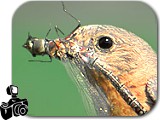 Nymphs
are eaten by many animals, including other aquatic insects,
fish and turtles. They are eaten by other nymphs, too! Dragonflies
are food for birds, frogs, spiders and other predatory insects.
Mass emergences of dragonflies along lake or river shores
can offer a banquet for predators. Large dragonflies often
eat smaller dragonflies! People eat dragonflies, too. In
some Asian cultures dragonflies are considered delicacies. Nymphs
are eaten by many animals, including other aquatic insects,
fish and turtles. They are eaten by other nymphs, too! Dragonflies
are food for birds, frogs, spiders and other predatory insects.
Mass emergences of dragonflies along lake or river shores
can offer a banquet for predators. Large dragonflies often
eat smaller dragonflies! People eat dragonflies, too. In
some Asian cultures dragonflies are considered delicacies.
 A
common parasite of both adults and nymphs are water mites,
tiny round relatives of ticks. Mites feed on the body fluids
of nymphs, then transfer to the adult as it emerges and
continue feeding. A
common parasite of both adults and nymphs are water mites,
tiny round relatives of ticks. Mites feed on the body fluids
of nymphs, then transfer to the adult as it emerges and
continue feeding.
|
|
|  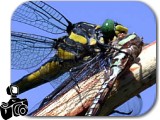 The
Dragonhunter (Hagenius brevistylis), our largest dragonfly
species (10 cm body length), specializes in hunting
large flying insects, and much of its diet ends up
being other dragonflies! The
Dragonhunter (Hagenius brevistylis), our largest dragonfly
species (10 cm body length), specializes in hunting
large flying insects, and much of its diet ends up
being other dragonflies!
|
|
|

Fly back to NatureNorth.com |
|
| |
|